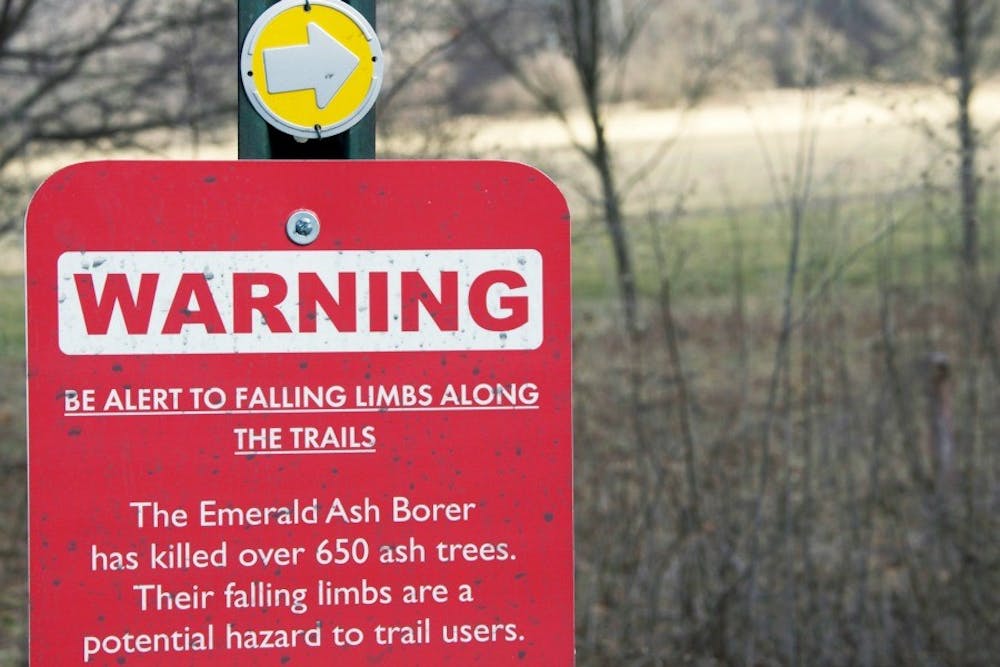By Karen Augenstein, For The Miami Student
Thousands of ash trees populate the many trails and natural areas surrounding Miami University, but these trees now present a risk to hikers and passersby, as an invasive pest is causing the upper limbs to become brittle and break off.
This invasive pest, indigenous to China, is the Agrilus planipennis - more commonly known as the emerald ash borer.
The emerald ash borer likely arrived in the United States on cargo ships from China in 2002 and was detected in Detroit 10 to 12 years ago. It moved into Ohio on the shipping pallets of semi trucks in 2003 and has since spread from its initial detection site near Toledo to all other parts of the state. It has begun to infest local ash trees in Miami natural areas over the past few years, according to the Ohio Department of Agriculture.
David Gorchov, a professor of biology at Miami, said stopping the emerald ash borer is extremely difficult once it has infected a tree. The female emerald ash borers will lay eggs in the back, and over the span of four or five years, the larvae will eat through healthy layers of the tree, eventually killing it.
While the death of ash trees impacts the environment, it can also be hazardous to the safety of Miami maintenance workers and students. When the emerald ash borer infects an ash tree, it typically begins killing off the top of the trees, causing large limbs to become brittle and fall off.
"It poses a risk if you're talking about trails or roads or parking lots or buildings - anywhere you have a high likelihood of a person being present," said Jessica McQuigg, a Ph.D. candidate for biology at Miami. "There is also a necessity for users of natural areas to be aware of these falling limbs."
Jim Reid, the field manager of the Miami University Trails and Natural Areas, said ash trees make up about 40 percent of the woodlands in Oxford. Currently, about 650 ash trees have become infested with the emerald ash tree, though it is estimated that all ash trees will eventually become infected. Because of the danger this can pose to users of the trail, certain ash trees that have become extremely infested and have extremely brittle, long branches are in the process of being removed.
"The implication is that tree should be removed soon in order to eliminate the chance of having some kind of property or human damage or casualty," McQuigg said. "When it comes to the maintenance teams, it really comes down to addressing these dying trees as quickly as possible before it becomes a hazard to public safety."
Another option is to treat the trees with chemicals. This can be done by injecting chemicals directly into the tree. However, this method has its drawbacks.
"Research has been done and it should be effective, but it will have to be repeated every few years, potentially forever," Gorchov said. "There are still going to be female emerald ash borers potentially laying eggs. It's effective, but expensive. It's not feasible in the natural areas where there are thousand of ash trees."
Miami has introduced this chemical treatment, in hopes that it may be able to save some of the trees. Unfortunately, McQuigg says, not all the trees can be salvaged this way.
"In my experience, when determining whether or not to save certain trees, you have to consider two things: what is the value of that tree to your landscape and what is the value of that tree historically?" McQuigg said. "When it comes down to it, we can't save every ash tree, not with the methods we have to use. It's not economically profitable, beneficial, and logically, we just couldn't do it."
With the likelihood that so many ash trees will be lost, Reid noted the importance of being aware of nature's processes.
"These are the natural areas. In nature, things occur that change the status quo. This is changing the status quo, but for good or bad, I don't know," Reid said. "This is just part of the evolution of nature."
Despite the increase in tree death, Gorchov noted hope for the long-term life of ash trees, as scientists are making efforts to discover emerald ash borer resistant trees.
"The U.S. Forest Service has done a great job collecting seeds of ash trees all over the country and are growing them up in areas where they are protected from emerald ash borer, and they are trying to find certain trees that have resistance so that they can cross breed them," Gorchov said. "So maybe, decades from now, we'll have recovering ash populations helped by the forest service and natural selection."

